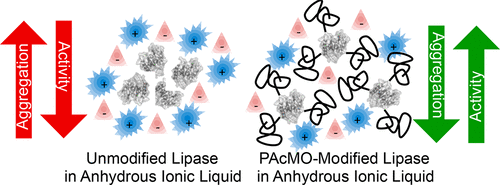当前位置:
X-MOL 学术
›
Biomacromolecules
›
论文详情
Our official English website, www.x-mol.net, welcomes your feedback! (Note: you will need to create a separate account there.)
Modification of Lipase with Poly(4-acryloylmorpholine) Enhances Solubility and Transesterification Activity in Anhydrous Ionic Liquids
Biomacromolecules ( IF 6.2 ) Pub Date : 2018-03-09 00:00:00 , DOI: 10.1021/acs.biomac.8b00176 Garrett R. Chado 1 , Elijah N. Holland 1 , Andrew K. Tice 1 , Mark P. Stoykovich 2 , Joel L. Kaar 1
Biomacromolecules ( IF 6.2 ) Pub Date : 2018-03-09 00:00:00 , DOI: 10.1021/acs.biomac.8b00176 Garrett R. Chado 1 , Elijah N. Holland 1 , Andrew K. Tice 1 , Mark P. Stoykovich 2 , Joel L. Kaar 1
Affiliation

|
Tuning the molecular interaction between enzymes and their solvent environment through polymer modification can greatly improve activity and thus utility in biocatalytic reactions. In this work, this approach was exploited to enhance the activity of lipase A (LipA) from Bacillus subtilis in anhydrous ionic liquids (ILs), which are highly attractive solvents for biocatalysis. Specifically, we showed that the transesterification activity of LipA in anhydrous 1-butyl-3-methyl imidazolium hexafluorophosphate ([BMIM][PF6]) was improved up to 19-fold via covalently conjugating the enzyme with the IL-soluble polymer poly(4-acryloylmorpholine) (PAcMO). The increase in transesterification activity correlated with an increase in LipA solubility in [BMIM][PF6] as well as, notably, the number of conjugated PAcMO repeat units. Light scattering results further showed that the attachment of PAcMO disrupted the aggregation of LipA in aqueous buffer, which was used as a proxy to understand the mechanism of activation of LipA in the IL, where aggregation was more pronounced. Additionally, using static light scattering, the Flory–Huggins interaction parameter (χ) for the polymer–IL interactions was determined (0.457). The favorable PAcMO–IL interactions presumably compensated for the unfavorable interactions between the enzyme and IL, which resulted in the improvement in dissolution and, in turn, activity due to reduced diffusional limitations. Through rationally considering χ, a similar approach may be used to tune the molecular interaction between other enzymes and ILs with other polymers, which has widespread implications for the enhancement of biocatalysis in ILs.
中文翻译:

用聚(4-丙烯酰基吗啉)修饰脂肪酶可提高无水离子液体的溶解度和酯交换活性
通过聚合物修饰来调节酶及其溶剂环境之间的分子相互作用可以大大提高活性,从而可用于生物催化反应。在这项工作中,利用该方法来增强枯草芽孢杆菌中的脂肪酶A(LipA)在无水离子液体(ILs)中的活性,无水离子液体是生物催化的极具吸引力的溶剂。具体而言,我们表明,通过将酶与IL可溶性聚合物poly()共价缀合,无水1-丁基-3-甲基咪唑六氟磷酸盐([BMIM] [PF 6 ])中LipA的酯交换活性提高了19倍。 4-丙烯酰基吗啉(PAcMO)。酯交换活性的增加与[BMIM] [PF 6 ]中LipA溶解度的增加相关尤其是共轭PAcMO重复单元的数量。光散射结果进一步表明,PAcMO的附着破坏了水性缓冲液中LipA的聚集,这被用作了解IL中LipA活化机制的代理,其中聚集更为明显。另外,使用静态光散射,确定了聚合物与IL相互作用的Flory-Huggins相互作用参数(χ)(0.457)。有利的PAcMO-IL相互作用可能弥补了酶与IL之间不利的相互作用,这导致了溶出度的提高,并由于减少了扩散限制而提高了活性。通过合理考虑χ,可以使用类似的方法来调整其他酶和IL与其他聚合物之间的分子相互作用,
更新日期:2018-03-09
中文翻译:

用聚(4-丙烯酰基吗啉)修饰脂肪酶可提高无水离子液体的溶解度和酯交换活性
通过聚合物修饰来调节酶及其溶剂环境之间的分子相互作用可以大大提高活性,从而可用于生物催化反应。在这项工作中,利用该方法来增强枯草芽孢杆菌中的脂肪酶A(LipA)在无水离子液体(ILs)中的活性,无水离子液体是生物催化的极具吸引力的溶剂。具体而言,我们表明,通过将酶与IL可溶性聚合物poly()共价缀合,无水1-丁基-3-甲基咪唑六氟磷酸盐([BMIM] [PF 6 ])中LipA的酯交换活性提高了19倍。 4-丙烯酰基吗啉(PAcMO)。酯交换活性的增加与[BMIM] [PF 6 ]中LipA溶解度的增加相关尤其是共轭PAcMO重复单元的数量。光散射结果进一步表明,PAcMO的附着破坏了水性缓冲液中LipA的聚集,这被用作了解IL中LipA活化机制的代理,其中聚集更为明显。另外,使用静态光散射,确定了聚合物与IL相互作用的Flory-Huggins相互作用参数(χ)(0.457)。有利的PAcMO-IL相互作用可能弥补了酶与IL之间不利的相互作用,这导致了溶出度的提高,并由于减少了扩散限制而提高了活性。通过合理考虑χ,可以使用类似的方法来调整其他酶和IL与其他聚合物之间的分子相互作用,


























 京公网安备 11010802027423号
京公网安备 11010802027423号